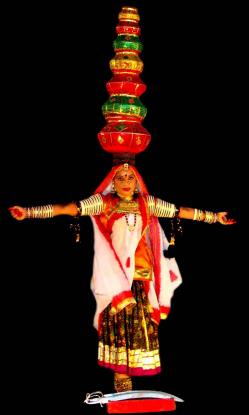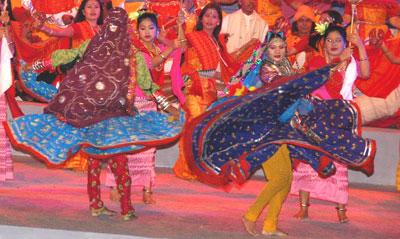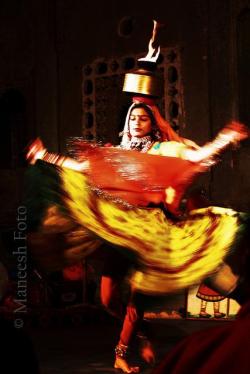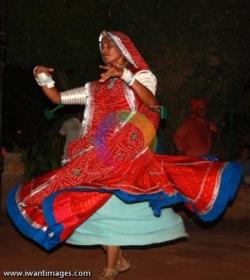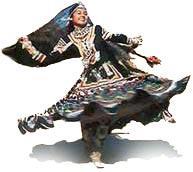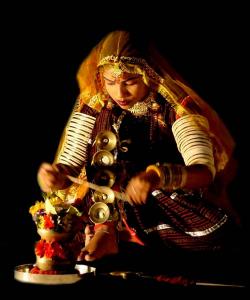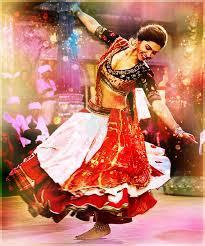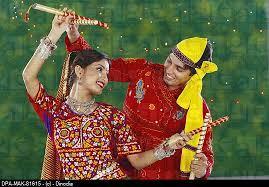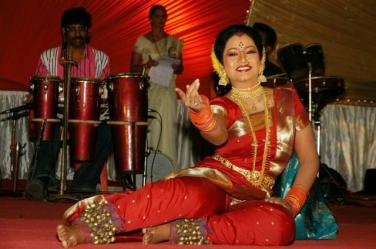Folk Indian dance
Folk dances from different regions of India
Besides the classical dances, each region in India has its own folk dances, from Bhangra Punjabi to Marathi Tamasha. The forms vary by ethnic groups, by region. These dances are usually of rural origin and are practiced by villagers for special occasions: crops, weddings, religious festivals ... There are sometimes professional companies which offer performances from village to village, especially when these are theatrical dances.
Dances of Punjab
Bhangra: This male dance is the most popular of Punjab and is also widespread to Canada or England, by the Indian artists famous abroad. Generally, a drummer is placed in the center of the dancers' circle, dressed in longhis (garment rolled and draped around the hips, covering the legs) and turbans. The movements are energetic, sometimes acrobatic and songs often use onomatopoeia.
Giddha dance
Ghidda: This is the female dance of Punjab, combining energy and elegance. Women dance in turns or couples, while the rest of the group beats the rhythm by clapping hands. One characteristic figure is to execute a dizzying pirouette. Traditionally, this dance is performed during a festival celebrating the beginning of the monsoon rains.
Dances of Rajasthan
In Rajsthan, folk dances are numerous, with frequent use of accessories such as pots, plates, weapons or sticks ...
Bhawai dance
Bhawai dance, originated in Gujarat, is directly inspired by the grueling life of women in the desert. The pots they balance on head illustrate the grueling march of women of the villages who traveled like this for miles in order to fetch water. The choreography also involves some "tests" (walking on broken glass or walking on a plate), which are actually a reinterpretation of the troubles and everyday problems these women faced. The word comes from the Sanskrit word "bhava", which deisgnates the aesthetic expression of emotions.
Chakri dance
Chakri: As the name resembles, Chakri, comes from ‘Chakkar’ (Circle), meaning rotation in hindi. This female dance practiced by Kanjars is remarkable for the rapid whirling movements that the dancers with floral dresses perform as if they are genuine live teetotums. This is especially a wedding dance, but it is also performed in other festive occasions.
Chari dance
Chari: Chari is a pot, in which, the women collect water for daily use. The lighted lamp placed on the pots makes it far more spectacular.The pots filled with lights worn by these dancers on their heads recall of a ceremony held during weddings. At a later time, there was no electricity in homes and everything was lit with oil lamps hanging from the ceiling or carried by oneself. These young women "wearing lights" symbolize the companion girls of the bride during the ceremony. The bride was veiled and hidden (and therefore kept in the dark) until she was allowed to meet her future husband for the first time. At that moment, the girls moved around the bride and lit her face, revealing her to her husband and to the audience.
Ghoomar dance
The "Ghoomer dance" will make us see 7 lavishly dressed women in saris of different colors. These women are all from a noble caste. Their face is veiled so that it should not be seen by other men of the assembly. The song and their gestures merely express a prayer addressed to their husbands. The whole choreography unfold in a circle and women also turn themselves around almost permanently, creating a kind of prayer cocoon in the center. They never stop facing the audience. Prayer can be exercised only in perpetual motion, always in a circle. 'Ghumna' means "turn".
Kalbelia dance
Kalbelia: The Kalbeliyas are a nomadic tribe living in the Thar desert in Rajasthan. They are called Sapera, "snake charmer". Many of the dancers movements resemble those of snakes. A part of the dance is executed in a standing position: very fast laps during which the dancer bends differently each time, giving the impression of a cobra's head turning in all directions. Another part of the dance is performed sitting on the lap: the dancers pick up objects placed on the floor (rings, paper money) with the mouth, leaning back, hands resting on the ground.
Terah tal dance
Tera tali: 'Terah' means thirteen. This is a very special female dance, performed by sitting women, while men sing and play their instruments. It is the dance of the thirteen beats produced by thirteen Manjeeras. These women place cymbals (Manjira) on various parts of the body (wrists, elbows, arms, waist, feet) and also hold some in their hands. With cymbals connected to a cord that she holds in her hands, the dancer has to hit these cymbals to the beat of the music.
Dances of Gujarat
Two dances are particularly known and popular in the state of Gujarat: Ras and Garba.
Garba dance
The Garba dance takes its name from a traditional oil lamp placed in a earth pot. A jug filled with water, also containing a betel nut and a silver coin, and finally topped with a coconut is the center of a circle of dancers who turn around it to the accompaniment of songs and percussion . This dance is practiced during major religious festivals such as Holi or Navaratri. The Garba dance would be a continuation of the ancient celebrations of a fertility cult in honor of a mother goddess.
Ras dance
Dances of Maharashtra
Lavani: This is a dance accompanied by singing, practiced only by women. The word comes from lavanya, meaning "beauty". The dancers dressed in nauvari sari (a nine yards material) perform energetic movements to music and songs with various themes: politics and society, religion, love ... It is said that this show was meant in the past (eighteenth and nineteenth centuries) to raise the morale of the army troops.
Last edited: 05/07/2021

























